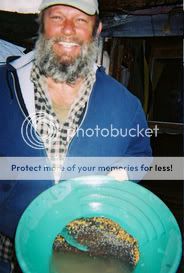Assay work is expensive and time consuming when done in a commercial assay lab.
It is possible for a prospector to use basic chemistry skills and get a usable analysis. The wet chemical approach uses chemicals that react with metals. This level of analysis can be used to get an idea of the quantity of copper, silver and GOLD in a sample.
Cautionary note:
The chemistry described here is general in scope to avoid a cook book description of chemistry that could lead unqualified persons into hazardous situations. The web has many resources that explain the details of how to accomplish the procedures vaguely outlined here. I encourage others to learn these skills under the supervision of an experienced professional.
"quantitative" analysis dictates accurate measurement of the weight of the sample. A high quality scale with calibration weights is a necessity. The sample is usually pulverized, dried, weighed and digested in a known chemical solution. The first step having the capability of reacting with copper and silver. The Copper and silver can be precipitated separately, dried and weighed individually.
Finally, the GOLD is dissolved and precipitated. The precipitate is dried and weighed.
Resources;
There are books on the subject. An excellent paper written by Hoke can be found online.
The objective is to get numbers that reflect the degree of precious metals including copper.
With sufficient time and financial resources, additional elements can be analyzed using an AA spectrometer.
Proper documentation of the sampling process and using a chain of custody improves the confidence of a potential investor/partner or buyer.
Next, we can look at extraction of the metals.
- Geowizard


